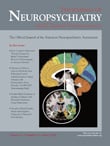To the Editor: Recent neurobiological studies indicate that schizophrenia may be a neurodevelopmental and progressive disorder with multiple biochemical abnormalities involving dopamine, serotonin, glutamate, and gamma-aminobutyric acid secretion. In postmortem tissue studies, structural abnormalities and alterations in synaptic connectivity have been observed in the intracortical circuitry of the prefrontal dorsal cortex of schizophrenia patients. These morphological changes could be the sequelae of earlier environmental insults and genetic processes. There are probably multiple susceptibility genes, each of small effect, which act in conjunction with environmental factors as obstetric abnormalities, intrauterine infection, and abnormal nutrition. Candidate identified genes could influence neurodevelopment, synaptic plasticity, and neurotransmission.
1 The recent findings are consistent with notions that epigenetic factors play a major role in the disease process and epigenetic factors may continue to influence the expression of the affected genes in adulthood.
2 It is also demonstrated that schizophrenia is a dynamical disease—i.e., that important aspects of schizophrenia can be understood on the basis of concepts of the theory of nonlinear dynamical systems.
3Chaotic dynamical systems are characterized by a lawful but delicate sensitivity to initial conditions. This leads to the observation that initially similar behaviors evolve into a striking divergence of behavioral patterns over time. Therefore, small differences in the input can result in an entirely different sequence of outputs.
4We believe that genes act as initial conditions and environmental factors are the control parameters of a chaotic human brain system, which can force the system to special states with particular characteristics (e.g., schizophrenia). Since in chaotic dynamical systems, control parameters can direct the system to special states, environmental factors play a key role in aggravation or decline of schizophrenia symptoms. This complies with some reports that showed high relapse rate of schizophrenia in families that expressed high emotion,
5 which can be considered as a positive control factor.
Based on our hypothesis, we propose that schizophrenia could be considered a chaotic model and the global features of the disease could be extracted instead of paying attention to local detailed features. In such a perspective, the manner of managing the disease will be changed. For example, we think that it is not necessary to include the effects of each part of the brain circuits and to correct any change in the amount of neurotransmitters; instead it is better to model the disease state as a chaotic system and recognize the interaction of different environmental factors, such as maternal health, birth complications, emotional states, familial relationships, etc., on it and try to minimize the pathological effects of them. We stress that it is not the compartments but the global interactions of different elements that play major roles in the disease and deserve attention. Modeling the behavior of schizophrenia on the basis of chaos theory to control the disease seems to be a good place to start.

